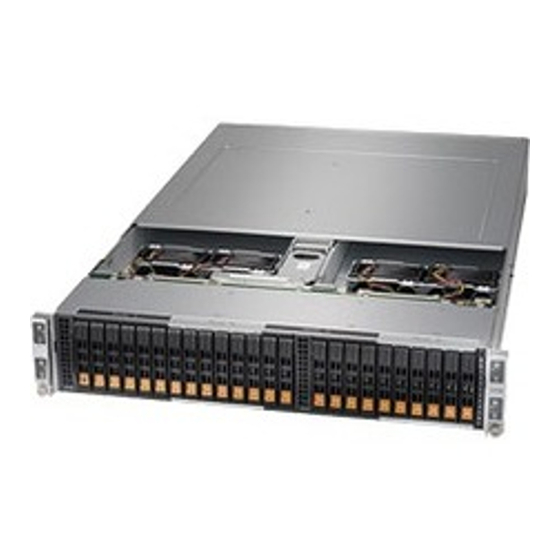
Table of Contents
Advertisement
Quick Links
This addendum addresses European Union (EU) Ecodesign requirements for servers and storage
products. All data and ratings within this addendum are in reference only to the Supermicro product(s) in
the manual. The below information conforms to requirements laid down in Annex II of the Commission
Regulation 2019/424.
3(1)(a):
See Section 1.1 of the system manual for the product type.
3(1)(b):
See the title page and preface of the system manual for the trademark and
manufacturer's address.
3(1)(c):
See the title page of the system manual for product model number(s).
3(1)(d):
See the serial number on the physical system to determine the year of manufacture.
3(1)(e-j):
PSU Efficiency and Power Factor Value (Table) (From 80 Plus report)
PSU Model #: PWS-
2K60A-1R
Watts:
% of Rated Load
Single Output (AC-DC)
Multiple Output (AC-DC)
System (EUT) Efficiency in
Representative
Configurations
High-End Performance
Configuration
Typical Configuration
Low-End Performance
Configuration
System (EUT) Efficiency in
Representative
Configurations
High-End Performance
Configuration
Typical Configuration
Low-End Performance
Configuration
Information for Lot 9 of ErP (Ecodesign)
2600W
10 %
90.42
N/A
Total Measured Idle
State Power (W)
961.7
NA
599.8
Active State
Efficiency Score
(Effserver)
40.1
NA
38.4
PSU Efficiency
20 %
50 %
95.83
96.22
N/A
N/A
Idle State
Power (Table)
Calculated Idle Power
Allowance per Node (W)
1519.9
NA
881.5
Active State
Power (Table)
Minimum Active State
Efficiency for 2-Socket
Server
8.0
Power Factor
100 %
50 %
94.37
0.99
N/A
N/A
Advertisement
Table of Contents

Summary of Contents for Supermicro AS-2123BT-HNR
- Page 1 This addendum addresses European Union (EU) Ecodesign requirements for servers and storage products. All data and ratings within this addendum are in reference only to the Supermicro product(s) in the manual. The below information conforms to requirements laid down in Annex II of the Commission Regulation 2019/424.
- Page 2 The first is with a Unified Extensible Firmware Interface (UEFI) shell utility. This utility works on X10/X11/H11/H12/M11 motherboard series with onboard SATA/NVMe devices. Any user may access and download this utility through following link: https://www.supermicro.com/about/policies/disclaimer.cfm?url=/wftp/utility/Lot9_Secure _Data_Deletion_Utility/ Download the shell utility package and extract it to a USB flash drive, then plug the drive into the server for which secure data deletion is necessary.
- Page 3 3(3)(a): There is no use of cobalt in batteries in this product. The indicative weight range of neodymium in the HDD is 0.0 if manufactured by Western Digital, and is between 5-25 grams if manufactured by Seagate. 3(3)(b): Please see the disassembly instructions on the next page.
-
Page 4: Data Storage Devices
Illustrated System Disassembly Instructions Please note: All the illustrations in the below disassembly instructions are for demonstration only. Components shown here may not match exactly with the components in your system. CAUTION: Always power off the system and unplug the power cord(s) first before disassembling the system! 1. - Page 5 2. Memory Type and number of fastenings: Two (2) latches per memory module. Tools required: None. Procedure: 1. Press both release tabs on the ends of the memory module to unlock it. 2. Once the module is loosened, remove it from the memory slot. 3.
-
Page 7: Riser Card
4. Riser Card Type and number of fastenings: Five (5) Phillips screws. Tools required: Screwdriver with PH2 bit. Procedure: 1. Remove the node from the chassis by pulling on the pulling ears. 2. Remove the screw at the center of the bracket. 3. -
Page 8: Expansion Card
5. Expansion Card Type and number of fastenings: One (1) Phillips screw. Tools required: Screwdriver with PH2 bit. Procedure: 1. Remove the screw holding the add-on card in place. 2. Carefully pull the add-on card out from the riser card. -
Page 9: Power Supply Module
6. Power Supply Module Type and number of fastenings: One (1) latch per module. Tools required: None. Procedure: 1. Unplug the power cord from the power supply. 2. Push the release tab on the back of the power supply module to the side and pull the module straight out. -
Page 10: Chassis Cover
7. Chassis Cover Type and number of fastenings: Two (2) Phillips screw Tools required: Screwdriver with PH2 bit. Procedure: 1. Remove the two screws that secure the top cover onto the chassis. 2. Lift the top cover up and off the chassis. Batteries Type and number of fastenings: One (1) latch. - Page 11 Fans Type and number of fastenings: One (1) fan header per fan. Tools required: None. Procedure: 1. Disconnect the fan's power cord from the backplane. 2. Lift the fan housing out of the chassis.
- Page 12 10. SIOM Type and number of fastenings: Five (5) Phillips screws. Tools required: Screwdriver with PH2 bit. Procedure: Riser Card 1. Remove the two riser brackets first, as instructed in Item 4, 2. Remove the five screws securing the pulling bracket to the node. 3.
- Page 13 11. Motherboard Type and number of fastenings: 11 Phillips screws. Tools required: Screwdriver with PH2 bit. Procedure: 1. Remove the adapter card, both riser cards, and SIOM first, as instructed in previous items. 2. Remove all 11 Phillips screws. Lift the motherboard from its base.












Need help?
Do you have a question about the AS-2123BT-HNR and is the answer not in the manual?
Questions and answers